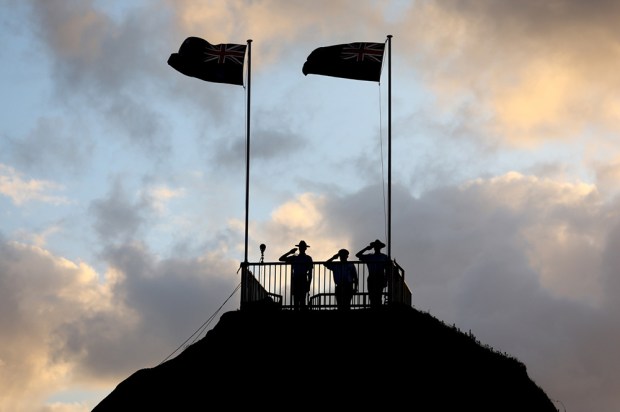One Saturday night late last year, two ‘white-skinned’ cricketers rolled into a petrol station on Sydney’s northern beaches having had a few too many beers after stumps. If you subscribe to the view of Australia being an irredeemably racist country, you might surmise what happened next: the stereotypical ugly Aussies unleashed a verbal torrent of racist abuse on the ‘brown-skinned’ attendant behind the counter.
What actually ensued was a friendly chat about cricket. The upshot was that the ‘bloke from the servo’ joined the team and opened the bowling the following Saturday.
This (true) story, which took place in the heart of Tony Abbott’s electorate, is an example of how and why Australia has become one of the most successful multi-racial societies in the world. The vast majority of Australians try and mostly succeed in looking beyond their differences to the things they have in common. An ethos of mutual acceptance, otherwise known as giving all comers a ‘fair go’, knits the social fabric in our neighbourhoods, workplaces, schools and sporting clubs.
We are now being warned that the glue that unites our diverse nation is in danger of coming unstuck if the Abbott government fulfils its election pledge to repeal in its entirety Section 18C of the Racial Discrimination Act. Section 18C makes it illegal to insult, humiliate, offend or intimidate another person on the basis of their race. This is the law the conservative newspaper columnist Andrew Bolt was found to have breeched by writing about race-based entitlements for Aboriginal people. The controversial Bolt case has major and well-rehearsed implications for free speech.
Having promised to take action to restore the right to freedom of expression, the Abbott government has been lobbied by human rights lawyers and ethnic leaders to change tack and avoid what is being portrayed as the highly divisive consequences of scaling back racial discrimination laws.
According to Race Discrimination Commissioner Tim Soutphommasane, dismantling Section 18C ‘may license racial hatred,’ ‘condone hate speech’ and ‘encourage people to think there is no harm in dealing out racial vilification.’ It may even, Soutphommasane warns, ‘unleash a darker, even violent side of our humanity, which revels in the humiliation of the vulnerable.’
In other words, repealing Section 18C threatens to unleash the racist attitudes presumed latent in the community, because the RDA is the proverbial thin blue line that keeps the dark underbelly of Australian racism in check. This was also the line run by the panellists (with the exception of Attorney-General George Brandis) during the unbalanced discussion of Section 18C on the ABC’s Q&A programme recently: the ability to drag people off to court was assumed to be the only thing keeping Australia a civilised country and stopping minorities from being racially vilified.
Soutphommasane’s forebodings are not only deeply patronising and highly insulting to ordinary Australians. His assessment, together with the sentiments expressed by the Q&A panellists, fundamentally mistakes and exaggerates the role anti-discrimination laws have played in making modern Australia a multiracial success story.
The RDA was introduced by the Whitlam government in 1975 and was more or less imported directly from Britain. It was based on the UK Race Relations Act (1965), even though immigration policy and attitudes towards migrants were very different in Australia compared to Britain. When the British Nationality Act was passed in 1948 people from the former colonies of the British Empire were granted the right of entry into the UK. However, nobody anticipated that over the next ten or so years, tens of thousands of ‘coloured’ people would emigrate from the West Indies, the Sub-Continent and East Africa. Because these migrants were not officially invited to come, no effort was made to prepare the British public to support and accept them. The unplanned and unexpected speed and scale of immigration in the 1950s meant that racial tensions arose by the early 1960s, including discrimination against migrants in housing and employment. In response, the Race Relations Act was legislated to try to cauterise manifest racial prejudice in Britain by outlawing all forms of racial discrimination.
In Australia, by contrast, the post-second world war immigration programme was carefully planned. Politicians explained to the public that the nation needed to ‘populate or perish’ and had to look beyond the traditional preference for migrants exclusively from Britain. Racial prejudice was also pre-emptively addressed. The public was told to welcome and accept the new wave of migrants from southern and eastern Europe as fellow citizens by calling them ‘New Australians’.
This set a clear cultural tone and marked the beginning of the development of the set of social manners — the ‘fair go’ ethos of acceptance and equality — that continues to predominantly characterise relations between Australians of all colours and creeds. By the mid-1960s, the idea that migrants from all backgrounds should be welcome and treated equally had become the foundation of public support for a (controlled) nondiscriminatory immigration policy. Hence a decade or so before the RDA, the last vestiges of the White Australia policy were able to be dispensed with by allowing migration from Asian countries.
This is strong evidence that it is the culture and not the law that made and keeps Australia an overwhelmingly tolerant and harmonious society. In Australia, unlike in Britain, we have never had to try to engineer racism out of the nation’s soul at the barrel end of the RDA.
Every year the Australian Human Rights Commission receives around 500 complaints of racial discrimination — not very many given the size and diversity of our population. However, the credit for how little racism there is should not go to the RDA. The idea that fear of the threat of legal action stops Australians from indulging in racist behaviour is ridiculous. This is as ridiculous as the idea that amending the RDA will unleash the so-called darker side of the Australian character. Every country has its proportion of racists, and having to encounter racism sometimes is the price we have to pay for not living in a mono-racial society. But for my money, the belief in the ‘fair go’ means Australians are the least likely people on earth to revel in the humiliation of an underdog, no matter their complexion.
The race-based scare campaign that is being waged against the repeal of Section 18C should not weigh heavily on the mind of the Abbott government. If the RDA withers, the ‘fair go’ culture that makes Australia a multiracial success will persist.
Got something to add? Join the discussion and comment below.
Get 10 issues for just $10
Subscribe to The Spectator Australia today for the next 10 magazine issues, plus full online access, for just $10.
Jeremy Sammut is a research fellow at the Centre for Independent Studies.
You might disagree with half of it, but you’ll enjoy reading all of it. Try your first month for free, then just $2 a week for the remainder of your first year.














Comments
Don't miss out
Join the conversation with other Spectator Australia readers. Subscribe to leave a comment.
SUBSCRIBEAlready a subscriber? Log in